#fatty liver cure
Text
The Fatty Liver Solution™ Duncan Capicchiano: A Comprehensive Reviews

The Fatty Liver Solution™, created by Duncan Capicchiano, promises to provide a natural and effective approach to tackling fatty liver disease. In this review, we'll explore what the Fatty Liver Solution offers, how it claims to benefit users, the cost of the program, and the additional bonuses included.
See More about "The Fatty Liver Solution" Here!
Understanding Fatty Liver Solution:
Author Background: Duncan Capicchiano, a Naturopathy expert, brings his extensive research and practical experience to the Fatty Liver Solution. The program is designed based on his knowledge and success in treating patients with fatty liver disease.
Program Overview: The Fatty Liver Solution is a guide that aims to educate users about the symptoms, root causes, and natural solutions for fatty liver disease. It emphasizes a holistic approach, avoiding prescription drugs and harsh diets.
Benefits of the Program: The program claims to help users achieve a healthy liver by addressing the imbalance between the body and healthy diets. Benefits include natural weight loss, restored skin health, and overall well-being improvement.
Click Here to Download PDF "The Fatty Liver Solution" eBook by Duncan Capicchiano!
What Fatty Liver Solution Offers:
Personalized Treatment Strategy: The guide provides a personalized treatment strategy for fatty liver disease, targeting symptoms like fatigue, flatulence, bloating, and high cholesterol.
Understanding Fatty Liver Disease: Users gain insights into the eight most common causes of fatty liver disease and essential information to navigate the condition.
Diet for Fatty Liver Sufferers: The program includes an exclusive diet plan with tips and delicious recipes tailored for fatty liver sufferers.
Herbs and Nutrients: Information on herbs and nutrients that aid in burning fat and promoting liver health is covered in the guide.
Secret Healing Shake Recipe: Users learn a recipe for a secret healing shake that supports liver health.
Insights into Western Medicine's Limitations: The guide delves into why Western medicine may not treat the root cause of fatty liver disease.
Step-by-Step Treatment Process: A unique step-by-step process for effective treatment is outlined in the program.
Juice Recipe for Vitamins and Minerals: A juice recipe is provided to ensure an intake of essential vitamins and minerals.
2-Phase Treatment Plan: The guide introduces a 2-phase treatment plan for comprehensive and lasting results.
Exercise Integration: Users discover ways to incorporate exercise into their lives to support liver health.
List of Ideal Places for Supplements: Information on the ideal places to purchase herbs and supplements is included.
Cost and Bonuses:
Program Cost:
The regular price for the Fatty Liver Solution is $97. However, a limited-time offer reduces the cost to $47.
Free Bonuses:
Users receive three free bonuses valued at $87:
Bonus 1: Complete Body Fitness eBook
Bonus 2: Glycemic 101 eBook – How To Effortlessly Control Your Blood Sugar
Bonus 3: Home Detox eBook
Money-Back Guarantee:
The Fatty Liver Solution comes with a 60-day, no-risk, unconditional 100% Money-Back Guarantee. Users can request a refund within 60 days if they are not satisfied with the program.
Conclusion:
The Fatty Liver Solution™ by Duncan Capicchiano, offers a comprehensive guide to understanding, treating, and preventing fatty liver disease naturally. With a holistic approach, personalized strategies, and valuable bonuses, the program aims to provide users with the tools to improve liver health. The inclusion of a money-back guarantee adds an extra layer of assurance for those considering the program. If you're seeking a natural solution to fatty liver disease, the Fatty Liver Solution may be worth exploring.
Click Here to Download eBook "The Fatty Liver Solution" PDF by Duncan Capicchiano!
#fatty liver#fatty liver disease#fatty liver cure#fatty liver test#fatty liver blood test#fatty liver treatment#fatty liver remedies
0 notes
Text

We’re discussing an incredibly important topic that affects millions of people around the world – treatment for liver disease. If you or someone you know is struggling with this condition, stick with us as we explore it. Best treatments available....
.
.
.
Sandhya Jani Devi Health Resort
7042735658
#fatty liver treatment#fatty liver#fatty liver disease#treatment of fatty liver#fatty liver diet#fatty liver symptoms#liver disease#liver#choline fatty liver treatment#fatty liver prevention#liver cancer treatment#treatment#fatty liver home remedies#fatty liver exercise#liver cirrhosis treatment#liver cleanse#symptoms of fatty liver#how to cure fatty liver#fatty liver explained#liver detox#fatty liver diet recipes#non alcoholic fatty liver disease
1 note
·
View note
Text
Planets and your health.
Ketu or south node gives diseses which could go undiagnosed till last stage.
Sometimes, diseases can't be diagnosed by any doctor, even patient will not able to understand but he/she can feel something wrong with her body..
Rahu is poison, any infection in your body that spreads rapidly, or poisonous insects or animals like snakes, bees are North node.
Food poisoning is also due to North node.
Any sudden event or disease is caused by north and south node.
People suffering from self harm or suicidal tendancy has bad north node or north node with moon.
Mars is blood, afflicted Mars will give skin problems and allergies
Remedy is to take Neem leaves or tablets every day and keep your blood clean.
Venus rules your tongue and your throat region, blisters and ulcers on throat and tongue are due to bad Venus.
Venus is also your skin glow and texture, so if you don't have skin glow it is due to afflicted Venus.
Mercury rules nervous system, bad Mercury gives neural problems and Mercury also rules your teeth, bad breath, cavity, and germs in your teeth is due to bad Mercury.
Jupiter rules your fat inside your body and your liver, bad liver, fatty liver, fat inside body is due to Jupiter.
Remedy is to drink turmeric water every morning.
Bad Saturn gives hair loss or hair fall, also Saturn rules all the joints inside your body, any pain in joints like arthritis is caused by bad Saturn.
Saturn also gives diseses which takes more time to be cured and heals slowly.
Moon is responsible for your mental health, problems related to stress, insomnia anxiety, phobias shows afflicted moon.
217 notes
·
View notes
Text
Been thinking about that transition weight gain post and such and it's like, there are definitely cases of weight gain* that are like, about your body doing badly whether it's like yr metabolism is fucked because of illness or medications fucking with you, often to an extent that you retain water and it's allllll just soooo miserable already without the added stigma of fatphobia that really feels like getting kicked while yr down.
*and this is like, very often about "looking bigger" not even like "gaining fat" or whatever necessarily
Especially considering that diets and other stupid shit have the potential to just make you worse - if you are all swollen because yr liver is fucked then messing with your bloodsugar levels and nutrition is not gonna make it better.
And like yeah the flipside of that is that you don't get to enjoy gaining weight as part of getting healthier but they feel so connected, right?
It's like, the complication of healthism within fat liberation (which I don't think is like, inherent to it!) - we cannot simply stop at saying "well healthy fat bodies exist" because like. Sick people also don't have the obligation to get thin. Sick fat people, generally speaking, will not be cured by losing weight, even (especially?) if any additional weight gain was the result of their sickness.
Like if we don't owe you thinness we don't owe you health either.
I think about this lot because I experience pressure to like, attempt weight loss from my diabetologist and it makes me feel like I have to be some sort of gold star bestest fatty who manages his diabetes like a boss but that's like insane. It's a chronic illness influenced by many factors, most of which are not, in fact, within my control. But I worry that if I refure weightloss and if my blood results get worse I will be blamed and abandoned.
10 notes
·
View notes
Text

@thebloodiestmary its idea is that fat should make up the largest percentage of your dietary intake, with as few carbs as possible. carbs are demonized to an extreme that has made them synonymous with “weight gain” and they’re treated like toxins or contaminants. there is an obsession to have as close to zero carbs as possible in your daily intake, although the general starting point tends to be “under 100g” as the novice and then graduates to “under 50g” as the intermediate.
most of the diet is, of course, animal products. high fat, slightly less high protein (excess protein is converted to glucose and thus evil), and minimal carbohydrates.
fiber, however, cancels out “bad” carbohydrates in this theory. if a food has 10g carbs, but 4g of those are fiber, then in the keto world that food contains 6g of “net carbs.” it is a crazy-making algebraic way of calculating your intake. and even though fiber is a focus, it is de-prioritized completely in this diet which is so full of animal protein and animal fat that i am not surprised to see many keto fanatics come out with bowel cancers or leaky gut or heart disease or high liver enzymes/fatty liver disease or gallbladder disease/gallstones.
the idea is no sugar, no carbs. as little glucose activity as possible.
people tend to lose weight on it usually because they are actually eating fewer calories than they usually would, but not realizing it. keto usually counts by macros, not by calories. in fact, it often discourages calorie tracking. this sounds promising, but it also means most people who lose so much weight with it don’t tend to realize that it’s because they’re in a large caloric deficit. it’s a scam! if you tracked your calories you’d probably realize you were in a deficit all along, and that THAT’S why you’re losing weight, not bc of some magical keto spell.
only eating meat and dairy and eggs will do that. meat and dairy and eggs are PRIMARY weight loss foods and always have been. keto fanatics feel smug because they’re eating bacon and steak and fried eggs and full-fat cheese, but they don’t realize how few calories they’re taking in by eliminating all other foods.
keto has a bad reputation for making its dieters paranoid about fruit, beans, whole grains, and even vegetables.
hardcore keto dieters barely get any of those in their diet. but they lose weight, so it must be healthy!
their boasting of “lower cholesterol” and “lower blood sugar” is almost certainly bc they are losing weight IN A CALORIC DEFICIT.
it is not possible to lose weight if you are not in a caloric deficit.
there is the famous “keto flu” onboarding stage where you feel sick and tired for about a week or sometimes more as you “wean” off of carbs. that is your body starving for nutrients lol. it’s starving. you feel sick and exhausted bc you have almost nothing going in.
and i can say this with confidence bc i fell for this diet hardcore when i was 20. i lost tons of weight eating “fatty” foods. what was actually happening was rabbit starvation—i was getting so much protein and so few other nutrients that i was actually starving myself.
it’s a poisonous diet, nothing more than a weight loss fad, wholly unsustainable, and wildly expensive btw.
any “benefit” that anyone claims comes from it is usually simply from the process of weight loss in a deficit if one’s original health problems (usually heart or diabetes related) were due to being overweight.
and yeah again i won’t even bother to get into what happens to one’s colon and bowels in general eating that many animal products and hormones and that much fat with little to no fiber. with all its parading of red meat and bacon and sausage and other cured meats, it’s a recipe for colon cancer, that’s all i’ll say.
it’s done so much damage to our understanding of food and balanced nutrition and it’s sneaky and dishonest in its ~famed results. it’s a fancy way of getting yourself into a caloric deficit, that’s all.
if all you ate in one day was a McDonald’s value meal at 1200 calories or whatever, you’d lose weight. you’d be in a deficit. keto makes you think it will be possible to consume 5000 calories of fatty fried foods and lose weight—but that literally is not what happens. you usually remain in a deficit because you’re starving trying to keep your carbs as low as possible. and you don’t notice it bc you’re not keeping track of calories, only grams of carbohydrates vs grams of fat.
so many topics exist on keto forums like “why am i not losing weight with keto?!” and answers will urge the user to eat less lmfao. or go on a “fat fast” to “get your body to prioritize burning fat as its primary source of energy” which is eating mostly like 90% fat as your intake majority with 0g of carbs. aka starvation.
you cannot train your body to “prioritize” fat as its primary source of energy. it will ALWAYS prefer carbohydrates as the most efficient and easily digestible source of fuel. the only way you can sustain “ketosis” (which is a dangerous medical condition btw) is by never feeding yourself enough carbs so that your body literally thinks it’s starving—BECAUSE IT IS!!!! you’re “burning fat” bc you are STARVING!!!!
and yeah. just. terrible for your gallbladder, your liver, your digestion, your heart, your inflammatory system, everything. horrific diet.
tl;dr—snake oil, low energy starvation recipe for bowel cancer!
25 notes
·
View notes
Text
Silymarin L-Ornithine L-Aspartate Syrup manufacturers and suppliers in India

Silymarin Vitamins Tricholine Citrate L-Ornithine L-Aspartate Syrups are used to prevent and cure liver diseases. This combination is a vital liver tonic that protects the liver from harmful chemical effects. It is a multifunctional liver tonic that is great for overall liver functioning.
Silymarin: It is used to treat chronic liver diseases. It protects liver cells from damage from free radicals. Its anti-inflammatory properties cure fatty liver and improve liver functioning. Studies suggest it may prevent liver cancer.
Tricholine Citrate: Tricholine Citrate removes bile acid from the body to produce liver more bile acid that lowers cholesterol. It is very helpful in cleansing the liver to function better.
L-Ornithine & L-Aspartate: L-Ornithine L-Aspartate is being used in reduced brain functioning in chronic liver diseases, liver cirrhosis, and hepatic encephalopathy.
Vitamins: Vitamins like b12 and b6 are beneficial for liver function. It improves blood circulation and purifies the blood.
In a combination of all these compounds, this liver tonic is useful for many ailments that affect liver function. It is also beneficial for non-alcoholic fatty liver. Moreover, it protects the liver from alcohol damage.
There are several liver syrups and tonics available in the market under various brand names. However, Silyrex Syrup (Composition: Silymarin + Vitamins + Tricholine Citrate + L-Ornithine L-Aspartate) is the best, and doctor's number one recommended liver tonic on the market.
Third-party manufacturing for vital liver tonics and syrups
Third-party pharma manufacturers in India are significantly contributing to the manufacturing of vital tonics and syrups. Liver syrups and tonics are among the most saleable medicines in India. Many pharmaceutical companies are outsourcing their production to contract manufacturers for their need for top-quality liver health syrups. The manufacturing of liver tonics needs precision production processes.
In India, Casca Remedies is the most advanced and innovative manufacturer in the pharmaceutical industry. We manufacture various syrups and tonics for vital body organs including the liver. Outsource your production needs to us, and we guarantee to deliver top-quality pharmaceutical products at the best pricing.
#Third-party pharma manufacturers in India#Third-party pharma manufacturers#Silymarin Vitamins Tricholine Citrate L-Ornithine L-Aspartate
4 notes
·
View notes
Text
Article Review - The Liver After Quitting Alcohol
Here is a quick summary/reflection on this article:
1. The liver is introduced as the largest internal organ and that it functions to break down toxins like alcohol. When alcohol is consumed excessively (more than 14 units), the liver undergoes the following changes: becomes fatty > healing from inflammation forming scars > many scars forming cirrhosis > liver fails > fatal outcomes. Symptoms associated with liver dysfunction are exhibited at late stages of impact.
2. Quitting alcohol has varying effects, depending on the condition of the liver. At the fatty stage, two to three weeks are sufficient to heal it back to normal appearance and function. For mild scarring/inflammation, a week can show significant improvements in the condition although full recovery may take months. With advanced cirrhosis or liver failure (where the liver is unlikely to cure itself completely), worsening of the condition or death could be prevented if followed through for many years. However, this withdrawal cannot be done suddenly, as it poses physical and psychological dangers and a medical professional has to be involved in planning a safe quitting programme in such cases.
3. Giving up alcohol also reflects benefits beyond the liver and improves outcomes in sleep, brain function and blood health. It also prevents cancer and cardiovascular diseases. Quitting should be integrated with practices like a good diet and regular physical activity to observe the best results.
In conclusion, this article was really insightful as an understanding of the liver’s power. I think anyone interested in the human body would find the author’s writing to be useful.
Disclaimer: This is purely a concise reflection on the points presented in the article. These are not my advice/opinions at all. I am only posting knowledge. Always seek a medical professional for healthcare assistance.
Follow @studyhaus for more articles!
#learning#studyblr#study#knowledge#science#technology#healthcare#medicine#article#reading#study motivation#study blog#studying#study notes#news#research#article review
12 notes
·
View notes
Text
Dear Sephiroth: (a letter to a fictional character, because why not) #63
I went to the grocery store today! And this time, I actually got some pictures of the general structure and layout! Because I know you said you wanted to know what is an ordinary life.
I don't know if these exist in your world in the same way, so maybe this won't seem very ordinary to you. But it's ordinary where I live, so here you go:
Most places will have the entrance directly in the produce section. This is where we find all our fruits and vegetables. There are lots of pictures because there are lots of different kinds of food here. Some of them come pre-cut and pre-washed; this is very convenient, and also makes it a lot easier for disabled people to cook on their own:



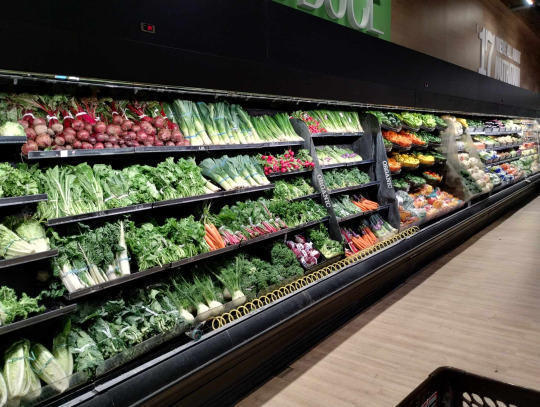
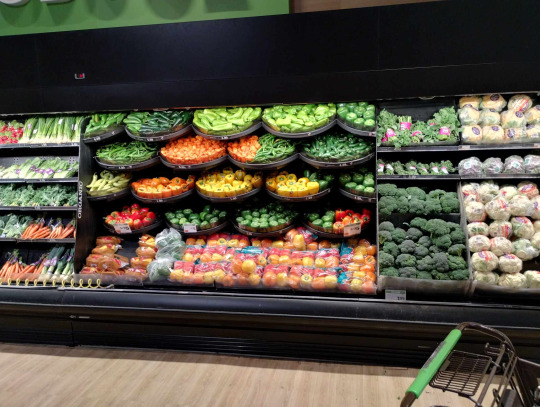
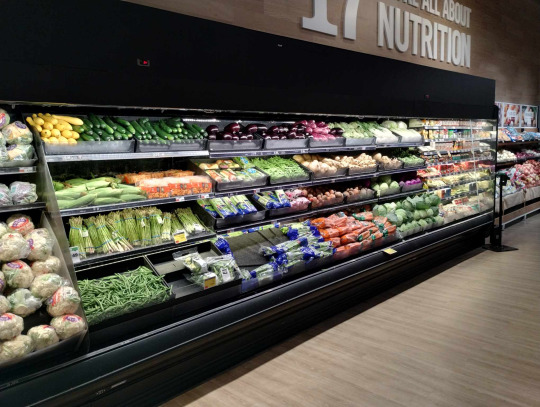

I got a broccoli, some asparagus, and some tomatoes from here!
There's also typically a section that contains deli meats and cheeses. These come whole in plastic packages, and then they get sliced up on special machines on request. This stuff is usually for sandwiches and the like.

I didn't get anything from this section, but I wanted to show it to you anyway!
You have the other cheese sections, too, which are... not for sandwiches? I guess that's the best way I can explain it - usually the cheese is split up for that which is intended for sandwiches and that which is intended for other things. But I don't usually discriminate when it comes to cheese; these are my favorite sections of the grocery store whether they're for sandwiches or not!! Because I am a cheese goblin!! It has been written!! It is known!! Ahahaha~! 😄
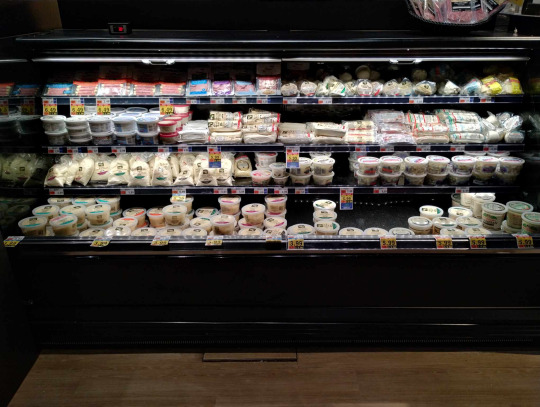




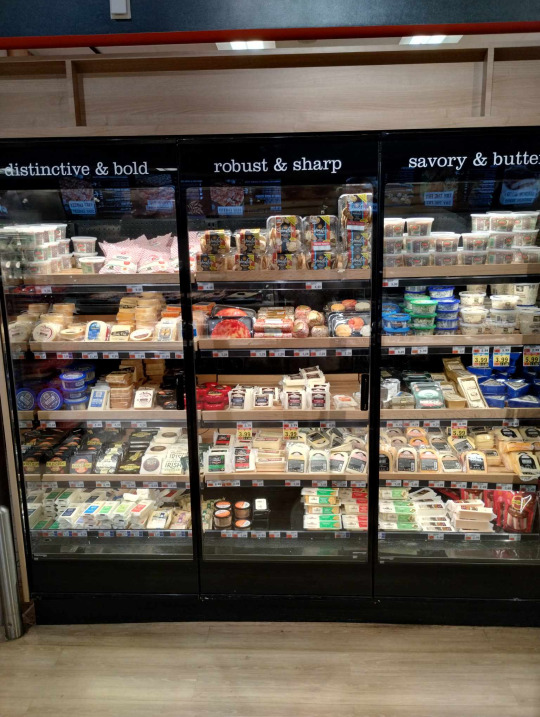
(sadly, I didn't get anything from this section today. but you can tell it's my favorite section because I have more pictures of this one particular food than of anything else!! hahahaha! 🤣🤤)
Over this way, you have the prepared foods section, the raw fish and raw meat sections, and the rest of the aisles:

This is the fish section! I only get salmon from here, because almost everything else is either too expensive or it has too much mercury in it, or both! Swordfish, for example, is a fish that lots of people in my world really like, but it's ridiculously expensive, and it's got a ridiculous amount of mercury in it, too, so I avoid it. Mercury is not good for the bodies of living creatures!

I did get salmon from here today. My world has farmed salmon; people say that it's bad for you in other ways, but I know that wild salmon are often not sustainably fished, and farmed salmon is cheaper anyhow, and it's very important to have omega-3 fatty acids in your diet (especially if, like me, you came out of therapy today with a massive paradigm shift; your brain is gonna need that stuff in order to build new neural connections properly; maybe I'll talk about it tomorrow)!
This section is where they put all the custom cut, pre-seasoned, and extra fancy raw meat:

It's in this section that you'll find lamb, wagyu, bison, pricier cuts of beef, and pre-seasoned and pre-marinated meats.
The rest of the raw meat section contains more standardized cuts that haven't been seasoned. It's divided into "beef and sometimes lamb" (it's a real treat when they get whole lamb leg on the bone; I love to season and roast those and save the bone for broth!), pork, "turkey, chicken and chicken organs", and then "other organ meats, things for stock or bird feed, and things that are purchased relatively rarely" - think beef liver, suet, pig's feet, chicken's feet, and marrow bones for making soup stock. But they don't always have those things.
This is the "beef and sometimes lamb" section:

This is the pork section:

Here is the turkey, chicken, and chicken organs, and organ meats sections:

I got chicken leg quarters from here! I intend to make them tomorrow, if I still have energy after my tasks and I'm not in too much pain!
Near these sections, in the middle, is where all the pre-cooked or cured meats are - things like hotdogs, cooked sausages, whole ham, and bacon. Here's an example:

This is where they keep the milk and cream:
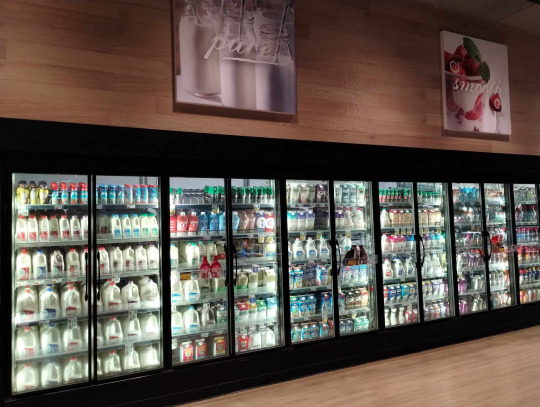
And here's where they keep breads and desserts:

I got a couple of surprises here, with you in mind! You'll see at the end! 😁
So far, I've only shown you the edges of the store. There are lots of aisles in the middle, which is where they keep non-perishable items, or items that aren't perishable until they're opened. Things like cereal, canned goods, dried goods, pasta, condiments, sugar, flour... stuff like that. The middle aisles contain lots of preserved or processed foods. Foods such as those aren't necessarily bad things, but it's generally important to make sure that processed foods don't make up your whole diet.
...Unfortunately, though, the reality of our world is that processed foods are generally a lot cheaper, so for most people, it's really all they can afford. I'm very lucky that I can get things like fresh fruits, fresh vegetables, and fresh fish. I remember when I was younger, and we could usually only get processed foods, meat, dairy, and bread.
In any case, here's the breakfast aisle:

You can find things here like cereal, oats, pancake mix, tea, coffee, honey, syrup, and stuff that people where I live generally like to eat for breakfast.
This is the honey and syrup section.

I got honey from here because we were out.
Next to it is the tea section:

I didn't get anything from here, but I decided to show it to you anyway because the colorful boxes are kinda pretty!
J was with me, and he decided to snag this picture of me taking pictures for you, for some reason! Hahaha!
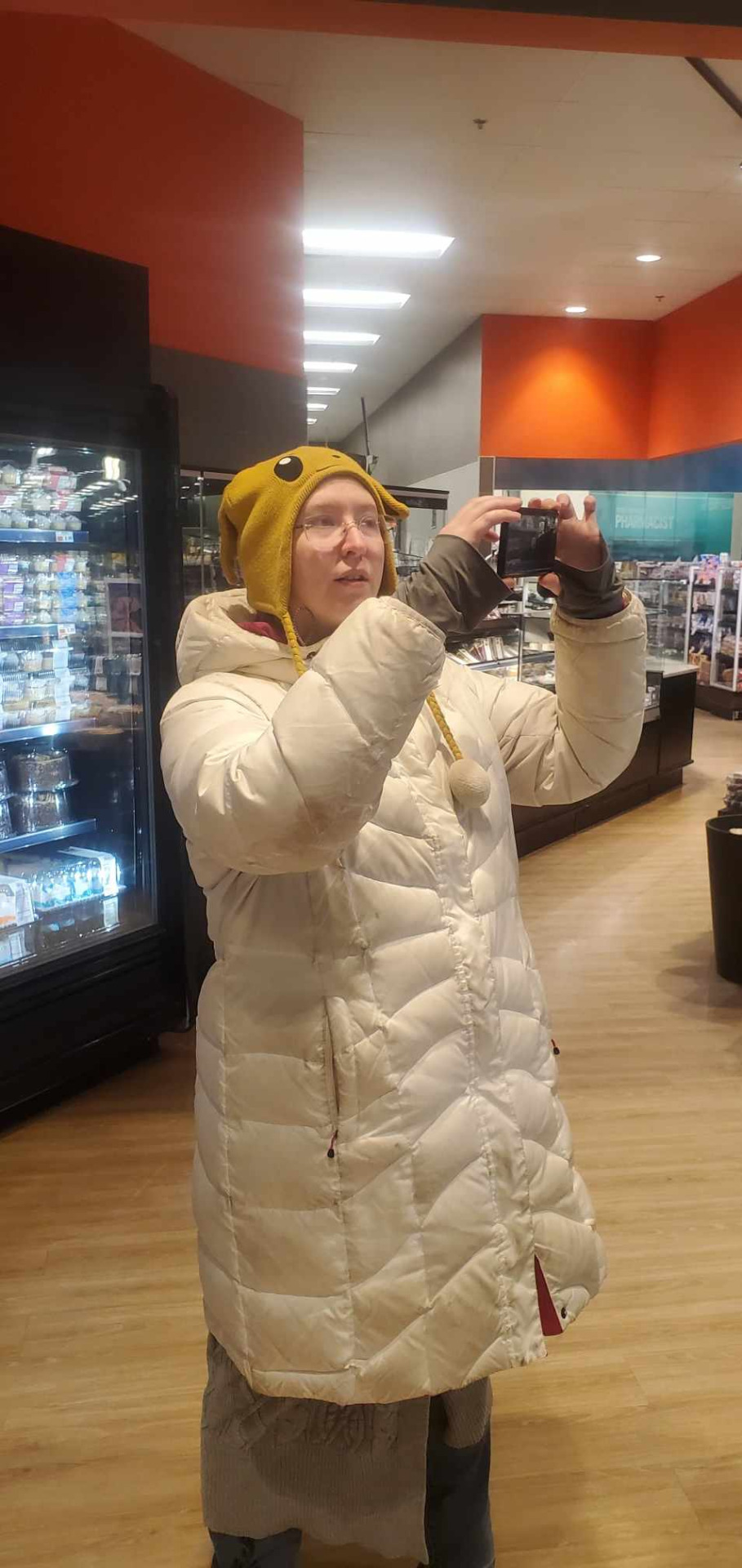
Anyhoot! We got home and put everything away! I guess it's time for me to show you the surprises I got! I don't know what you like for dessert, but it's hard to go wrong with things like chocolate and raspberries, I think!
This one is a chocolate cheesecake with purple raspberry frosting and fresh raspberries on top!

This one is a raspberry mascarpone tart thing!

And this one is a chocolate truffle tart thing!

...And... I know I can't give these to you. But I think you would like them if I could. If nothing else, please know that there are people in this world who would get tasty snacks for you just because they think you might like them.
Thank you for coming on this adventure with me. I know that a grocery store is probably just an ordinary thing, but you've indicated before that you just want ordinary things, and... even ordinary things can be turned into full adventures if you're carrying enough curiosity, joy, excitement, and love inside your mind. Even if you go to the same place lots of times, there is still always something new and beautiful to discover, if only you look closely at everything with fresh eyes.
You are loved because I love you. And lots of other people do, too. So don't do anything stupid to get yourself killed, got it? We need you here. We need to see you heal. We need you to be okay in the end. Please. Because there's still so much you haven't seen. There are still so many delightful and wonderful and beautiful things that you haven't experienced. Don't go around thinking like pain and misery are the only things that life can offer you. You're not done yet.
I'll write again tomorrow, so please keep yourself safe.
Your friend,
Lumine
#sephiroth#ThankYouFFVIIDevs#ThankYouFF7Devs#ThankYouSephiroth#final fantasy vii#final fantasy 7#ff7#ffvii#final fantasy vii crisis core#final fantasy 7 crisis core#final fantasy crisis core#ffvii crisis core#ff7 crisis core#crisis core#ff7r#final fantasy vii remake#final fantasy 7 remake#ffvii remake#ff7 remake#final fantasy vii rebirth#final fantasy 7 rebirth#ffvii rebirth#ff7 rebirth#final fantasy 7 ever crisis#ffvii ever crisis#ff7 ever crisis#ffvii first soldier#grocery store#ordinary adventures#wholesome
11 notes
·
View notes
Text
If you’re a fan of Jewish delis that serve breakfast, then you likely have a soft spot for the LEO. No, we’re not talking about your uncle; we’re talking about the classic zhuzhed-up scramble made with lox, eggs and onion that’s a staple everywhere from Russ & Daughters in New York, to Kenny and Ziggy’s in Texas, to Wise Sons in California.
The LEO is an ode to the building blocks of Jewish American Ashkenazi food. While you might think of lox as an ancient Ashkenazi food, salmon wasn’t actually a common ingredient in Eastern European cuisine. When Jews immigrated to the United States in the early 20th century it coincided with a time when salmon was being amply shipped from the West Coast. Salmon is clearly ideal for smoking and curing with its fattiness and subtle flavor, and lox quickly became a favored deli staple.
As for onions – caramelized ones are an essential, and make for an inexpensive way to add a big depth of flavor to a wide range of dishes. Think: bialys and chopped liver. My grandmother seemed to constantly be standing over a stove stirring onions in a skillet until golden brown, and then adding them to just about every savory dish she made. That said, the shade of your LEO onions are a personal preference; if you like them on the paler side, simply sauté them for less time. Buttery eggs bring everything together with their rich, intrinsically dairy-free, hearty friendliness. A final garnish of chives or dill adds a touch of freshness.
The LEO is always a nostalgic, satisfying breakfast, no bagel required (but absolutely welcome on the side). This recipe comes together in under half an hour and can be doubled as needed. For that reason, I love serving this to friends and family as an easy, flavor-filled brunch.
6 notes
·
View notes
Text
Heirloom Kitchen, Old Bridge NJ
My wife and I enjoyed an absolutely first class dining experience today at Heirloom Kitchen in Old Bridge, NJ.
Food was good, almost shockingly good. I was taken aback at the subtlety of just about every dish we were served. Atmosphere was clean and quirky, somewhere at the intersection of cottagecore, industrial, and kitch. Service was top notch, attentive and professional, from a brigade that couldn't have been much older than my teenage sons.
The menu was a four course prix fixe, including dessert ($89 pp). Tonight's menu featured three or four choices for each course, so we had (difficult!) choices to make. As usual, we ordered extras: a stuffed bread course (which was amazing, both sweet and savory, with onion jam and a whipped feta spread), as well as two a la carte dishes as an additional course, (which the staff sequenced perfectly, despite our last minute addition).

Our first course was a raw cured snapper served in watermelon lime broth and a chicken liver mousse served on brioche. The snapper was served like ceviche, cured in citrus, but served over a vivid red watermelon broth. The flavor of the lime oil popped with the crisp texture of the fish, and rode nicely over the sweetness of the watermelon.

The toasted brioche was topped with a modest shmear of a velvety chicken liver mousse, which would have been a sensational pairing all by itself. But the bite was taken up several notches with the addition of pickled veg, micro cilantro, and emulsified jalapeno on the plate. The acidic and mildly-spicy pop was so helpful to cut the cloying fattiness that normally comes with chicken liver. Very well balanced and clever to keep the spicy element separate on the plate, allowing the diner to dial in their preferred level of heat.

Course number two consisted of grilled octopus and a baked squash. The octopus dish was a master class in the Maillard reaction: just about every item on the plate was cooked to caramelization, but not a single element had that burnt flavor you get when something is left in the pan a few minutes too long. Eggplant, nuts, capers, potato, and even the za'atar - each cooked to its own smoky sweetness then combined perfectly in a harmony like an exquisite campfire.

The Delicata squash was served in tender cubes over acorn squash rendered as a mousse and had several different textures across the dish. The apple mostarda complimented the squash in both a expected yet surprising way. That familiar homey flavor of simple baked apples with squash and cinnamon took on a much more sophisticated demeanor in this context.

Our third course was a pan-seared fluke and a pork belly deconstructed "tamale". The fish had a great crust and flavor, but could have maybe used one minute less in the pan. But we like our fish under rather than over, so it might have been personal preference. The pepperoni butter was the most surprising element, and one we are going to try to replicate. Each of the other elements - the cassoulet, the sofrito, and the caponata - were executed well enough to stand on their own; in combination, they supported the fluke without overwhelming it.

The pork belly was cooked "birria" style, a slow-cooked stew with meat and spices. This dish was clever and incredibly flavorful, with a generous portion of extremely moist and tender pork belly. The corn portion of the deconstructed tamale was served central to the dish, as a simple rectangle covered in the mole sauce. I enjoyed the texture that the corn and wax beans added to the dish, especially given the silky tamale/mole centerpiece. My only wish was that they had gone with a birria "tatemada" style of cooking, where the pork belly was crisped up after being stewed. I missed the sensation of crispy pork fat in my tamale, and I worry that the large moist fat cap on the pork belly might turn off some patrons. But that's just a tiny tweak, not at all a complaint.

Our bonus course consisted of a pasta dish (Sorpresine), and the duck breast we thought we had to sacrifice in lieu of the pork belly. When our server told us in casual conversation that we could add dishes a la carte, we jumped at the chance to fill in with some of the dishes we had missed. Sorpresine (meaning "little surprises") is sort of an unstuffed version of ravioli. Just folded and cooked, this pasta was served with a sticky-sweet peach agrodolce, tiny tomatoes, and a very moist stracciatella cheese, sister to ricotta. We were so pleased we were able to get this complex yet rustic dish into our menu. It simultaneously felt subtle and lush in my mouth while being reminiscent of Sunday dinners at my grandma's house.

The duck breast was served in a Jamaican style, with a dry jerk rub, a habanero jus sauce, and braised cabbage and squash. The large portion of duck breast was cooked perfectly medium rare, a lovely light warm pink in the center. We cut it into medallions, and smeared each through the spicy jus. While I loved the flavor, I really wanted a more substantial jerk sauce, sticky and clinging to the meat. This dish had such an island inspiration but fell slightly short on the thin jus. The cabbage was tasty but slightly overly-salted to my palate. All of the other flavors were spot on, however, and I wouldn't hesitate to order it again.

Last course was dessert: we had the hush puppies, and the inspired combination of basil mousse/olive oil cake/Parmesan ice cream. I have to admit I wasn't wild about the hush puppies. Served with caramel popcorn and a smear of creme "elote" anglaise, this clearly chef-inspired dessert fell flat for me. I wanted more fresh in-season fruit, instead of the one lonely bit of peach and gooseberry. I wanted more delicious sauce, instead of the tiny smear. The hush puppies and popcorn were fine but their focus should have been reversed, IMO.

The other dessert was a delightful exercise in contradiction and challenging your preconceptions. Basil mousse, parmesan ice cream, olive oil cake, pine nut brittle - this sounds like the ingredients to a nice savory pesto dish, not a dessert. However, here's a chef's dessert that knocked the ball out of the park on so many levels. The olive oil cake was a moist platform for the ice cream and a tart lemon curd. The pine nut brittle paired as expected with the basil ice cream but the surprise was that it works as a sweet dessert as well as in a savory main. This dish was just over-the-top clever in its conception, almost like it was the response to a dare: "Make a pesto dish, but dessert - go!" However the good balance of sweetness and acid from the lemon and texture from the brittle, all melting together and soaking into the tight crumb of the cake was so startling in its "challenge accepted", perfect execution.
Again, service staff was exquisite, more attentive than many restaurants asking twice the price. Busers were on the move continuously but not obtrusive. Runners knew their food preparation and could answer questions thoughtfully. Our server was funny, engaging, offering her own thoughts and opinions while remaining thoroughly professional throughout
Decor was an interesting mix. Edison bulbs, black fixtures and flatware. Seating that matched but also seemed to come from a yard sale. A library of cookbooks and an open kitchen all contributed to the informal, casual feel. I thought the music was at times a bit too loud for easy conversation though. Our server told us the restaurant started life as a cooking school, and in fact still offers cooking and baking classes, as well as a multi-course tasting experience on Sundays.
Please forgive the extensive review here. I feel like this restaurant is quite possibly one of the best in the state. More than being a "hidden gem", this experience was easily a 5-star fine-dining experience, tucked into a little strip mall off Route 9 in Old Bridge. I literally do not know if they're aware of the incredibly high quality of the experience they offer, and the value you get as a patron. But I suggest you bring an adventurous palate and a few friends for dinner at Heirloom Kitchen before they wise up, put linen tablecloths over their neat wooden tables, and double the prices. But even if that happens, you can count on seeing me there (just wearing my jacket and tie).
Happy Eating!
12 notes
·
View notes
Text
So I was recently diagnosed with NASH (Non-alcoholic steatohepatitis). This means Fatty Liver that's causing damage to the organ. The only cure for this is weight loss of at least 10% of my body weight and an overhaul of my diet, and exercise. If I don't, it'll lead to cirrhosis and potential liver cancer which is something I'd VERY much like to avoid.
How did I get this? Bad diet, being overweight. But bad diet mostly. It also apparently comes for folks with PCOS easier. Does this mean if I was skinny I'd not have this problem? Nope! If I was skinny but my diet was the same I'd still have gotten fatty liver! 1/4 adults have a fatty liver, 1/10 kids have a fatty liver, and a percentage of those go on to start causing damage. It's set to be the top cause of liver transplants within the next 15 years.
So! Yeah! Heads up: even if you're skinny, if you eat a load of garbage there's a chance you already have a fatty liver, and if you keep going you might wind up damaging your liver as bad as an alcoholic's without having drunk a drop. Scary shit, not fun, do not recommend. Avoid saturated and trans fats when you can, eat lotsa leafy greens, go easy on the carbs, etc. Your liver can undo a lot of damage, but once it reaches a point it's kinda permanent.
3 notes
·
View notes
Text
Essential Basic Health Check-Up Tests in Bhubaneswar for Early Detection and Prevention
Taking care of our health is no longer a luxury—it's a necessity. With the hustle and bustle of modern life, people often neglect their health until a serious issue arises. This is where the concept of a basic health check-up becomes crucial. Early detection and prevention are the keys to maintaining a healthy lifestyle, and in Bhubaneswar, several health check-up packages are available to help you stay ahead of potential health risks. These tests are simple, non-invasive, and designed to give you an accurate picture of your overall health.
If you're looking for basic health check-up packages in Bhubaneswar, this blog will guide you through the essential tests you should consider for early detection and prevention. We will also cover convenient options for those in Odisha who prefer health check-ups at home.
Why Basic Health Check-Ups Are Essential
Many serious health conditions, such as heart disease, diabetes, and certain cancers, develop without noticeable symptoms in the early stages. By the time you feel unwell, the condition may have already progressed. Regular health check-ups can catch these issues before they become severe, giving you time to take action and improve your health. Prevention is better than cure, and a basic health check-up test in Bhubaneswar can help you identify any early warning signs of illness.
Essential Basic Health Check-Up Tests
Here are some essential tests included in a basic health check-up package that focus on early detection and prevention:
1. Complete Blood Count (CBC)
A CBC is one of the most common tests included in any basic health check-up test in Bhubaneswar. It gives a detailed overview of the different types of cells in your blood—red blood cells, white blood cells, and platelets. Abnormal levels can indicate infections, anemia, immune system disorders, and other health conditions.
2. Blood Sugar Test
Monitoring your blood sugar levels is crucial, especially for detecting diabetes early. A fasting blood sugar test checks your glucose levels after not eating for several hours. This test can help detect prediabetes and diabetes, enabling early intervention to manage the condition effectively.
3. Lipid Profile
A lipid profile measures your cholesterol levels, including LDL (bad cholesterol), HDL (good cholesterol), and triglycerides. High cholesterol is a significant risk factor for heart disease, which is why this test is essential for anyone interested in preventing cardiovascular issues.
4. Thyroid Function Test
Thyroid health is often overlooked but plays a critical role in regulating metabolism, energy, and mood. Many health check-up packages in Bhubaneswar include a thyroid test package in Odisha, which assesses your T3, T4, and TSH hormone levels. This test can detect conditions such as hypothyroidism (underactive thyroid) or hyperthyroidism (overactive thyroid), both of which require medical intervention.
5. Liver Function Test (LFT)
Liver health is crucial for detoxifying your body and metabolizing nutrients. An LFT checks for enzymes and proteins in your blood that indicate how well your liver is functioning. Elevated levels can point to liver disease, fatty liver, or the effects of medications.
6. Kidney Function Test
Your kidneys filter waste from your blood and regulate various essential functions, including electrolyte balance and blood pressure. A kidney function test measures the levels of urea, creatinine, and other waste products in your blood to assess kidney health.
7. Electrocardiogram (ECG)
For those at risk of heart disease or with a family history of heart problems, an ECG is a non-invasive test that records the electrical activity of the heart. It can detect abnormalities in heart rhythm, which could be a sign of heart conditions.
8. Urine Routine Test
A simple urine test can provide valuable insights into your body's metabolic and kidney functions. It can detect infections, diabetes, dehydration, and other metabolic disorders.
9. Vitamin Deficiency Tests
Many people suffer from undiagnosed vitamin deficiencies, especially in essential nutrients like Vitamin D and B12. These deficiencies can lead to fatigue, mood disorders, and other health issues. Checking for vitamin deficiencies as part of your health check-up test packages in Odisha ensures that you are not missing out on any essential nutrients.
Choosing the Right Health Check-Up Package
With so many basic health check-up packages in Bhubaneswar, how do you choose the one that’s right for you? Here are some factors to consider:
1. Your Age and Risk Factors
If you're young and healthy, a basic package that covers the CBC, lipid profile, and blood sugar might suffice. However, if you're older or have a family history of certain conditions, you might want to opt for a more comprehensive package that includes tests for heart health, liver function, and thyroid health.
2. Customizable Packages
Some healthcare providers offer customizable health check-up packages. This means you can choose tests based on your personal health needs. For example, if you're particularly concerned about thyroid issues, you could add a thyroid test package in Odisha to your check-up plan.
3. Convenience
In today's world, convenience is key. Many healthcare centers offer health test packages at home in Odisha. This means that you can get all the essential tests done without leaving the comfort of your home. This is especially beneficial for individuals who have busy schedules or find it difficult to visit a healthcare facility.
4. Price and Value
While it might be tempting to opt for the most affordable package, it's essential to consider the value you're getting. A slightly more expensive package that includes critical tests like the thyroid test package in Odisha might be more beneficial in the long run.
Benefits of Health Check-Ups at Home
One of the most convenient options now available in Odisha is health test packages at home. This service allows healthcare professionals to visit your home, collect samples, and provide you with results without the hassle of visiting a clinic or hospital. Here are the main benefits:
Convenience: No need to travel or wait in lines at a diagnostic center. You can book a time that suits you.
Comfort: For elderly patients or those with mobility issues, getting tested at home is much more comfortable and stress-free.
Accuracy: Even at home, trained professionals collect samples with the same precision and hygiene standards as they would in a clinic.
Comprehensive Packages: Many service providers offer a wide range of tests, from basic CBCs to more specialized tests like thyroid or kidney function assessments.
At Diagnostic Point, for example, they offer health check-up test packages in Odisha that can be customized to include essential screenings, all performed at home by a team of experts.
When Should You Get a Basic Health Check-Up?
If you haven't had a check-up in the past year, now is the time to consider one. The frequency of health check-ups depends on your age, lifestyle, and medical history. Here are some general guidelines:
For young adults (18-39 years): A basic health check-up every 1-2 years is advisable. If you have risk factors such as smoking, obesity, or a family history of diabetes, you may want to consider more frequent check-ups.
For middle-aged adults (40-60 years): You should have a health check-up every year, especially to monitor cholesterol, blood sugar, and heart health.
For older adults (60+ years): An annual health check-up becomes even more important as the risk for chronic conditions increases with age.
Conclusion
Early detection and prevention are key components of maintaining a healthy lifestyle. By opting for a basic health check-up package in Bhubaneswar, you're taking a proactive step toward managing your health and preventing serious conditions from developing. Whether you visit a clinic or prefer the convenience of health test packages at home in Odisha, regular check-ups can make a significant difference in your long-term well-being.
Diagnostic Point offers a range of customizable health check-up test packages in Odisha, designed to meet the needs of every individual. Book your check-up today and invest in your future health.
#health test package at home in odisha#health check up test packages odisha#basic health check up test in bhuvneshwar#basic health check up packages bhuvneshwar
0 notes
Text
6 Foods Good for Liver Detox

Why liver detox?
Based on a 2020 study that was published in the Journal of Clinical and Experimental Hepatology, between 25% and 30% of Indians overall have NAFLD (Non-Alcoholic Fatty Liver Disease). This is in line with results from additional research showing an elevated prevalence of the condition. NAFLD is more common in men than women, with an estimated prevalence of 40% in men and 26% in women. A healthy liver is very crucial for holistic health.
Here you can track down the 6 foods good for liver detox that will help you in liver detoxification:
Also Read: 6 Ways to Detox Your Liver at Home
Apple and liver health
You must have heard of “an apple a day keeps the liver at bay.” It is because Apple have antioxidant and anti-inflammatory properties as it are rich fiber and other nutrients. It supports metabolism and with its high hydration properties, it flushes out all toxins in the body, supporting gut health. Vitamin C and potassium in apples are involved in metabolic processes that can aid in liver health.
When life gives you lemons, make a lemonade
When life gives you lemons, give your liver a boost. Lemon plays a crucial role in detox diet. Start your day with warm lemon water; this can help kick start your metabolism. You can add salads or make smoothies to boost the flavor that will complement Vitamin C for your body. Lemons stimulates digestive enzymes and further reduce oxidative stress. Maintaining a balance between free radicals and antioxidants is crucial for protecting liver health and function.
Why olive oil?
One of the components of Olive oil, hydroxytyrosol, has been shown to reduce negative effects of fatty liver disease. It supports insulin sensitivity, reduces inflammation, and enhances fat metabolism. Olive oils have monosaturated fats, whereas the other oils are rich in omega 6 fatty acids and saturated fats. Monosaturated fats improve the lipid profile and other liver-related conditions.
Liver’s best friend (Garlic)
When it comes to liver health, garlic acts as an ally in the kitchen. Consuming raw garlic is one of the most effective way to support your liver health. It reduces fat accumulation and supports immune function. The antioxidants in garlic, including selenium and vitamin C, help neutralize harmful free radicals in the liver. Through its rich content in sulfur, it stimulates liver enzymes and promotes detoxification.
Nuts to boost liver’s roots
Nuts can fortify and support the basis of liver function, Nuts like walnuts, cashews, almonds, and brazil nuts are rich in omega 3 fatty acids, vitamin E, magnesium, and zinc that can promote healthy weight, healthy digestion, support immunity and reduce liver’s burden. The unsaturated fats present in nuts can prevent NAFLD.
Avocados
Avocados are an excellent source of glutathione, which protects liver health, guards the liver from unwanted toxins, and strengthens the liver's cleansing function. It is also rich in Vitamin B6 and Vitamin C, which act as antioxidants, reversing oxidative damage to protect liver.
Also Read: Say No to Fatty Liver
TAKEAWAY
"An ounce of prevention is worth a pound of cure.” Other than the food mentioned above, one can incorporate watermelon, banana, salmon, pumpkin, tomato, tuna, mung beans, papaya, and grapes into nutrition plan. What you eat and how you move determines your gut health. Chronic oxidative stress is linked to various liver conditions like NAFLD, Alcoholic liver disease, hepatitis, and liver cirrhosis. Balancing your diet with plenty of fruits, vegetables, whole grains, and lean proteins while staying hydrated and exercising regularly can support liver health and overall well-being.
#fitliver#liver#healthcare#health & fitness#healthylifestyle#benefits#health and wellness#wellness#nutrition
0 notes
Text
Can Homeopathic Treatments Offer Relief for Fatty Liver Sufferers?
Fatty liver disease (FLD) or hepatic steatosis is a disease categorized by the excessive accumulation of fat in the liver where it can cause inflammation, fibrosis and other sequels. While modern medicine goes on investigating for cure, people who suffer from this condition seek solace in homeopathy among other practices. However, homeopathy, as an effective non-conventional medicine has solutions back home for people with the problem of fatty liver? In this blog, one will explore whether homeopathy is effective when used a complementary therapy to deal with fatty liver disease.
Understanding Fatty Liver Disease
Fatty liver is commonly classified into two types: Fatty liver is commonly classified into two types:
Non-Alcoholic Fatty Liver Disease (NAFLD): This form occurs in those who rarely or never indulge in taking alcohol products or even those that take it occasionally. It’s often expected with pathologies like obesity, diabetes type II, hyperlipidemia and lipodystrophy, inclining towards a sedentary lifestyle.
Alcoholic Fatty Liver Disease (AFLD): Although there are several treatments for the AFLD, it can turn into more advanced stages such as alcoholic hepatitis or cirrhosis if produced by the overindulgence of alcohol.
The Role of Homeopathy in Managing Fatty Liver
I would like to remind that homeopathy is a comprehensive system of medicine which uses highly diluted substances to activate body’s self-singing reactions. Hence it seeks to embrace a more holistic approach to healing whereby the patient is diagnosed as a complex organism and not just the disease. Homeopathy isn’t probably going to cure fatty liver disease by physically removing it but it may assist in reducing fat in the liver through enhancing the liver’s ability to perform its duties while at the same time targeting the causes of fat deposition.
Benefits of Homeopathic Treatment for Fatty Liver
Holistic Approach: Continuing with an introduction on homeopathy-the system not only gives attention to the patient’s physical status but also to his/her mental and/or emotional status. This could be of help when it comes to handling the fatty liver since it tries to treat not only the liver function but also the factors that came with it such as digestion, metabolism, and stress.
Minimal Side Effects: Due to the claimed potency being within the drops or pellets, homeopathic remedies are thought to be relatively safe and without side effects due to which they are quite popular among people who prefer natural treatment over the conventional pharmaceutical ones.
Addressing Root Causes: Specifically, homeopathy addresses the factors that lead to the formation of fatty liver including unhealthy nutrition, lack of exercise or possible metabolic disorders. Thus, the mentioned factors may be helpful for using homeopathic therapy for avoiding further development of the disease.
Complementary to Conventional Treatments: Fatty liver disease and homeopathy: how homeopathy can complement conventional medical approaches. Such a combined approach may help improve global results due to the treatment of the liver and reduction of symptoms while making lifestyle modifications that include diet and exercise to address the origin of the issue.
Limitations and Precautions
In as much as homeopathy provides a customized and physiological approach to treatment of fatty liver, its shortcomings must be noted clearly. Nonalcoholic fatty liver disease particularly at the stages of steatohepatitis or cirrhosis needs treatment through consultation with the doctor and adopting healthier lifestyle changes. Homeopathy may not be enough to try and reverse the scenario or state in question on its own.
Any person considering HPT for their current ailment should first talk to his/her healthcare provider as a first step to facilitate the use of homeopathic remedies. Homeopathy should not be used as a substitute for conventional medicine but it should be used in conjunction with conventional medicine.
Conclusion
Our holistic approach to treat fatty liver disease thus ensures that the patient’s body receives a gentler treatment while the liver is supported to work effectively. In fact, such homeopathic treatments are rather helpful and can alleviate the symptoms as well as support the work of the liver if administered with other types of treatments. If the person is interested in the natural and holistic system of medicine then they should consider taking homeopathy treatments because it can supplement the conventional methods of treatment with other changes such as dietary changes and exercises.
All in all, the overall effectiveness of homeopathic treatment for fatty liver depends on the individual approach of an experienced homeopath and patient’s willingness to make the necessary changes in his or her lifestyle for the sake of the liver.
Visit our website- www.drkhuranahomeo.com
0 notes
Text
Best Fatty Liver Doctor in South Delhi Lajpat Nagar Call 8010931122
If you are looking for the best fatty liver doctor in South Delhi, Dr. Monga at Dr. Monga Clinic in Lajpat Nagar is the expert you need.
With extensive experience treating liver conditions, Dr. Monga provides personalized care for patients suffering from fatty liver disease.
The clinic focuses on a holistic approach by combining medical expertise with lifestyle changes to manage and cure fatty liver problems.
For professional and compassionate care, schedule an appointment with Dr. Monga by calling 8010931122 and take the first step towards better liver health.

0 notes
Text
Innovation against isolation and loneliness and the role of cities.
Nic Palmarini, Director, UK's National Innovation Centre for Ageing.
The four horsemen vs. the wonder drug.
We know very well who are the Four Horsemen of the Apocalypse who - typically in late adulthood - come banging on the door of our lives and who amount to over 80% of deaths in people over 50 who do not smoke: Atherosclerotic disease (comprised of cardiovascular disease and cerebrovascular disease), Cancer, Neurodegenerative disease (Alzheimer's disease being the most common) "Foundational disease", a spectrum of everything hyperinsulinemia to insulin resistance to fatty liver disease to type 2 diabetes.
We know just as well that to counter them, besides the science on which the redeeming business model of cure is based, there is only one actual wonder drug: prevention. The literature is vast and consolidated on choices and virtuous behaviours: sleeping well, staying active, a balanced diet, keeping the mind engaged and sustained by a purpose, and a strong network of relationships.
On the first four aspects, much technology has made its fortune in recent years by exploiting the mobile + IoT boom boosted by increasingly effective and sophisticated machine learning systems thanks to the mass of data generated by us, with thousands of applications combined with sensors to measure performance, metabolism, stress or the level of attention, in other words, our quantified self. Much less, however, has been done to help us live 'with' and 'in' a society whose social and economic dynamics are prone to exacerbate phenomena such as isolation and loneliness. It must be admitted social connection - the structure, function, and quality of our relationships with others - is still an underappreciated contributor to individual and population health, community safety, resilience, and prosperity.
Technology-supported innovation solutions have mainly focused on care - formal or informal - led by the American trailblazers (the historic Papa and Honor, the now defunct Heroes, and the rising star CareYaya), which have inspired hundreds of start-ups all over the world that have literally copied their logic and services, and then declined some aspects of it until arriving at the various' grandchildren rental' we have in Italy. A mainly "care-like" approach, we were saying. Without forgetting the founding pillars of Apple, Meta, Google, and Amazon - the enablers of the digital dynamics of relationships - who invest in innovation to promote relationship, engagement, participation, and inclusion?
In fact, the first question would be: what kind of society finds itself renting grandchildren to make up for its lack of essential interaction? To answer - however superficially and without opening what would be a necessary chapter on the founding values of each culture - we are obliged to refer to an 'advanced Western society', even in its relational decline. It is no coincidence, in fact, that grandchildren rentals are the clone of what, eight years ago, it seems like a geological era, Chuck McCarthy observed in Los Angeles as a dramatic social phenomenon and - to that - responded with The People Walker [1].
Faced with the emergence of the isolation of men and women in the inner cities as well as in the suburbs of middle-class America, and well before the phenomenon was amplified by a devastating event such as the COVID-19 pandemic, McCarthy accompanied hundreds of strangers on foot for thousands of miles walking people who were isolated in their home and without anybody to have a walk with, to earn a few extra bucks and get himself out of the house more too.

"Twice a week for the past month, I've paid an underemployed actor $30 an hour to walk me through the hills of L.A. like a Labrador. Chuck McCarthy isn't a dog walker, though; he's a people walker."
Attesting to a cultural difference between the smooth social fabric of U.S. megacities where larger cities are basically two-tiered (a wealthy downtown professional class relies on inexpensive labourers who can't afford to live near their workplace or drive a car; who are forced into long commutes creating a sort of a social vacuum) and that of old Europe is as obvious as it is necessary.
Europe, particularly Italy, has a profoundly different urban context, population distribution and social fabric. Without going into the merits of factors such as population density per square kilometre or the role of the Church, one fact suffices: in Italy, among people aged 75 and over, 51% live no more than one kilometre from their nearest child and 20% live with them. Only 8.9% have no children and live alone, and only 0.9% have children far away abroad[1]. And yet, even though this figure is all in all an exceptional dimension, isolation is a phenomenon that - in the face of a society that is progressively older, urbanized and increasingly enveloped in the violent polarization of its digi-social loops - shows all its disturbing pervasiveness.
Isolation and loneliness are not the same thing.
Social isolation and loneliness are often cited as one Siamese brothers, inextricably linked. But they are not the same thing.
We have often associated old age with loneliness out of principle or narrative convenience because, all things considered, it is more effective and easier to narrate. Loneliness is a feeling that develops when there's a perceived difference between desired and actual levels of social interaction, meaning, and relationships. Loneliness is a subjective state and more easily strikes the imagination because it appeals to that feeling we all know well, that fear we all had as children when, for a second, we lost sight of the reassuring face of mum or dad. We felt lost, abandoned, and deprived of that need for care that accompanies puppies of all species like the whole life suddenly has no meaning. We felt lonely. Imagining an older man alone strikes at the heart because it strikes at our childhood self.
And so, we talk about the 'pandemic of loneliness', not distinguishing it from isolation, which instead refers to social relationships, social roles, group membership and the social interactions that ensue. Not only that, isolation relates to not only 'presence' but also to inclusion. Its form is, therefore, more insidious and more challenging to portray. People living alone can still feel content with their level of social activity, and people physically surrounded by others can still feel lonely and disconnected.
The relationship between isolation and loneliness is dynamic and interconnected, where one dimension contributes to triggering the other with often devastating consequences. But the triggering process seems straightforward. An observational Harvard study published in SSM–Population Health sought to find out if one problem might be more dangerous than the other. Researchers analysed the health data of almost 14,000 people (ages 50 or older) who were followed for four years. Both loneliness and isolation were associated with poor health outcomes. But, social isolation was a stronger predictor of physical decline and early death. Loneliness was more predictive of mental health issues, such as depression or feeling that life had no meaning[2].
In ancient times, humans relied on social bonding and communication with others for "mutual aid and protection"; becoming socially isolated was essentially a risk to one's survival and almost a sentence to death. Today, we have enough data to give dimension to the evidence that common sense has always suggested. The lack of social connection poses a significant risk to individual health and longevity. “Loneliness and social isolation increase the risk of premature death by 26% and 29%, respectively. More broadly, lacking social connection can increase the risk of premature death. In addition, poor or insufficient social connection is associated with an increased risk of disease, including a 29% increased risk of heart disease and a 32% increased risk of stroke. Furthermore, it is associated with an increased risk for anxiety, depression, and dementia. Additionally, the lack of social connection may increase susceptibility to viruses and respiratory illness”[3].
Although these data refer to late adulthood, which is the subject of our interest on this occasion, to think that loneliness and social isolation are phenomena of old age is a distortion, again, driven by common stereotypes such as thinking of young age as that of lightness, carefreeness, social relations and therefore free from the phenomena of disconnection and participation. We know very well that this is not the case, and recent data, in some worlds, suggested by the Pandemic, have indeed shown us the extent and seriousness of these phenomena for the younger generations with a particular risk of social isolation not only experienced but also simply perceived.
These include and are amplified by changes in peer development, autonomy development, identity exploration, cognitive maturation, social perspective development, and physical maturation. This is baggage whose weight then spills over throughout life with consequences that are still difficult to measure objectively longitudinally but which to ignore would be a colossal mistake both contextually and prospectively. It, therefore, becomes clear that in the face of this scenario, social isolation and the resulting risk of loneliness no longer represent a mere contextual dimension to the horsemen of the apocalypse: they are often its initiator and silent accelerator.
Innovation means fighting the root causes.
As we usually do, addicted to a pathology-centric and cure-centric model (the current medical and pharmacological business model), we focus on the effects with little interest in the causes. If we do not focus on the causes, in fact, not only do we content ourselves with promoting palliative forms whose efficacy is yet to be proven (least of all, in this case, the idea of a 'magic pill' that 'cures' isolation or loneliness makes sense) but we also actually limit the development of that innovation capable of suggesting system solutions instead of praesidium solutions.
In our analysis of root causes, 'Loss' appears to be the main trigger factor[4].
Loss of physical and mental ability: Health issues can limit one's ability to attend and participate in social activities with others;
Loss of family and friends: Social networks naturally shrink over time if not maintained, eventually leading to isolation;
Loss of professional identity: Many underestimate retirement's emotional impact from the sudden reduction of daily social interactions;
Loss of recognition in media and market: Aging stereotypes perpetuate older adult portrayals as dependent on others and non-contributing;
Loss of social status: The concept of ageing often becomes associated with loss of social status, recognition, and value;
Loss of a purpose in life: Difficulty in finding purpose after retirement can be an isolating experience that drives societal disconnect;
Therefore, if we want to stimulate system innovation, we must ensure that any solution designed to mitigate loneliness and isolation must target the underlying cause – loss. And like treating similar devastating physical ailments like heart disease and diabetes, the most effective solutions support identification and preventative action.
To prevent loss and keep older adults connected and engaged in their communities, we must re-think many aspects of society, from employment to education, transportation, housing and more. Researchers, advocacy groups, and public health workers need better tools to aggregate and mine data, identify at-risk people and communities, and deploy interventions more quickly. And when loss does occur, older adults need tools and support to build and enhance their social capital in the same way they might nurture financial capital. Serving older adults involves many stakeholders – family, caregivers, healthcare practitioners, and social workers – all of whom want to work in a more connected way but lack the underlying structure or tools to do so.
Currently, there's no effective or accurate way to screen for isolation or loneliness – no standard tool or protocols exist. Loneliness can often hide in plain sight as it often presents with other conditions such as poverty or depression. And in North America and northern Europe, cultures that can place a high value on independence and stoicism, there's a real stigma to admitting to loneliness and an unwillingness to seek help.
There is also a pervasive assumption that older adults are reluctant to use technology, but did we ask them? Did we provide a meaningful, usable, accessible technology for them?
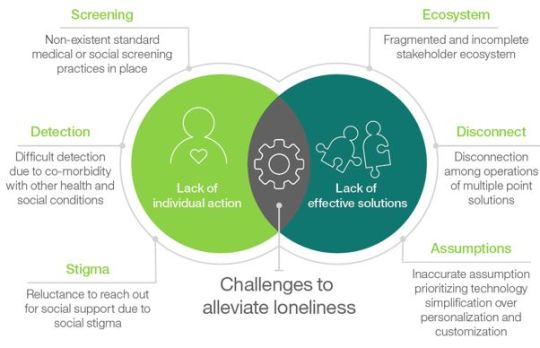
Abstract from Loneliness and aging: Navigating an enduring crisis [6]
As usual, where we see an issue related to ageing, we should also be open-minded enough to see the opportunity since - given the global economic system in which our society is rooted - the only way to reduce inequalities and scale solutions that can help a broader population is to identify the opportunities for the potential stakeholders. Which might not be "the usual suspects". There is enormous opportunity across multiple sectors, and no one industry or organisation will have a "magic button" for this issue – instead, the best solutions will cut across industry silos, from universities working with communities to create inter-generational housing for students and seniors, to telecom providers working with electronics vendors on virtual town-square projects, to self-driving vehicles – whose more enthusiastic audience may be older adults, because the reward to risk ratio is so high. The potential of cognitive and IoT technologies to deliver data integration, personalisation, natural language processing and scalability will be essential to support these solutions.
How do we create a new kind of village?
Three main questions can drive innovation:

Even if isolation and loneliness can happen in every context – a crowded condo, a school room, a dance hall, a public park in a village or a neighbourhood -it is also true that we are part of the global urbanization trend that suggests that the "new kind of village" described before resembles more and more to cities.
For the first time in human history, in 2008, most of the world's population was living in urban rather than rural contexts, and rapid global urbanization means cities are the dominant environment in which we will live not only as younger people but also into later life. Cities are the symbolic and physical representation of the intersection of our cognitive, affective, and behavioural components and the highest expression of the evolution of our intelligence and social systems we have created.
This – seems an unstoppable trend – makes cities more exposed to the consequences of age-related social and demographic changes, the different stages of individual human experience and social interaction. "With more complex social composition and variation in living standards, and the greater degree of human design and initiative that their functioning requires (for example, in terms of mobility, digital environment and built environment), they have the potential to help us accelerate the understanding of not only how we mitigate, adapt, or manage changes in society but also proactively influence it and transform from passive, adaptive, assisting containers, to being active tools for our through life well-being, health - our longevity. Cities have a fundamental role and clear opportunity to suggest forward proposals rather than reactive responses to living longer, better lives, with better social circumstances and sustainable, economic growth"[2].
Benjamin Barber and others have suggested that cities could succeed in various areas of public life where nation-states have struggled to make progress.
"The challenge of democracy in the modern world has been how to join participation, which is local, with power, which is central. The nation-state once did the job, but recently, it has become too large to allow meaningful participation even as it remains too small to address centralised global power… The solution stands before us… Let cities, the most networked and interconnected of all our political associations, defined above all by collaboration and pragmatism by creativity and multi-culture, do what states cannot."[9]
Furthermore, "City and local governments are in a prime position to tackle the social determinants of health because of the breadth of their responsibilities over a defined geographical area, with powers cutting across different areas of public policy. This ability to take a place-based approach is important because of the way that health needs and outcomes are distributed spatially. In most cities, the greatest levels of need are concentrated in neighbourhoods where poverty levels are highest and social outcomes are poorest. Improving health outcomes in these areas requires multi-sectoral action and leadership from those with an overarching responsibility for place"[4]. Most of the actions taken by city governments impact the health of citizens, and most of that is not about health care per se but about transport systems, urban design, planning and all the other functions and tools that city governments have at their disposal.
It is a mistake to think of the city as a unicum. There is a central government of the city, which is what we need to strategically direct policies. Still, the city is an aggregate of villages, of communities with such specific peculiarities that they have repercussions on the health and lives of citizens. Take London, for example. The highest life expectancy for both women is in Kensington and Chelsea, with 84.1 for men and 87.9 for women. The lowest life expectancy is found in Barking and Dagenham for both men (77.0 years) and women (81.7 years). This makes it a whole seven years less than in Kensington for male residents. The next lowest was Greenwich, Newham and Lewisham. Healthy life expectancy for women ranges from 57.8 years in Tower Hamlets to 70.1 years in Wandsworth. In contrast, for men, life expectancy ranges from 58.1 years in Barking and Dagenham to 70.2 in Richmond upon Thames[5]. It is clear that while London is narrated and imagined as the city we all know for the Big Ben or Piccadilly Circus, it is also evident that it is made by so many different nuances so well described by data on healthy life expectancy.
So, in these contexts, we must develop innovation policies to combat isolation and loneliness, but with a central government that identifies a common goal, which can only be the health-adjusted life expectancy of its citizens or HALE. In the recent past, for too long, we have focused on measuring life expectancy tout-court. Still, the transition we are experiencing from an ageing society to a longevity society requires us to imagine policies and services that aim to create not only a citizenry that lives long but does so healthily. I will not dwell on why this is a crucial step, as I would like to emphasize how this must become the pivotal' policy effectiveness' objective to be shared between city departments.
Every single initiative, from a more effective sewage system to the redesign of public transport to speed limits in city centres, must always and in any case be contextualized and measured against its corresponding 'Return in Healthy Longevity'. Suppose we establish this KPI as our focus. In that case, we can not only easily understand where to prioritize our interventions (perhaps Chelsea can be placed in the queue compared to Tower Hamlet) but also more quickly understand the drivers of the reasons for such a difference. Economic and social factors (per capita income and education) underlie these macro-differences but understanding "how" and "how much" these factors, along with all the other components that impact our health, influence isolation - which, as we have said, is probably the spark from which loneliness is amplified - is what can allow us to intervene quickly.
Historically, the moral thermostat of politics is fixed on a point somewhere between duty and prudence. Unhinging this dynamic is intrinsically complex, and perhaps the only way to do so is to unlock a basic principle, namely to formally acknowledge that, as we have said, no one industry or organization will have a 'silver bullet' for this issue, and therefore to involve each actor in a hybrid model not by offloading responsibility onto one another, but by coordinating interaction with one another and developing an ecosystem opposed to the current fragmented and partial one.
By leveraging data and technology to establish an absent shared screening and detection model. Who can tell if a person is isolated? How can we distinguish whether depression is caused by loneliness rather than by other factors? Who communicates the data with whom? Who cares to act? Just the usual charities or voluntary groups in the area? And even if so, can we systematize volunteering? Can we launch campaigns to combat the stigma associated with old age and the shared celebration of independence as a symbol of a healthy and progressive society? Are we sure that it is only up to the U.N. or a ministry to run such campaigns? Wouldn't it be more effective and pervasive if brands were the ones to convey this message?
Isolation and loneliness should be tackled with the same vigour we strive for a net-zero footprint. Where everyone is involved, where everyone offers joyful communications to keep our planet habitable. Where everyone sells an opportunity with a return on their investment, which is not merely social, it is economic. The opportunity for innovation is contextualized (mostly) in cities and concerns every business sector.
The city, the enabler of innovation.
It would seem, therefore, that the city bears most of the responsibility for the solutions and that it is up to central, local, and hyperlocal public administrations to find the investments and provide the tools to implement them. At least, this is how it should be in the welfare state that we have, perhaps at one point in history, idealised in an eternal debate between hyper-liberalism and the nanny state. This is a distorted representation. As Michael Lyons says: "The local government is not an agency responsible for delivering a specific set of statutory services. Rather, it is a government unit responsible for the well-being of a community and a place, and independent of, whilst also being connected to, the wider system of government".
In other words, it is up to local (and hyper-local) governments not to deliver the solutions but to build the ecosystem in which they can be born, proliferate and resolve. A function of knowledge, promotion of evidence, prioritisation, and coordination. In an economic and social context, it is radically different from when many of the policies that are still in place today were designed. A context plagued by new forms of isolation and loneliness exacerbated by new social dynamics, digital ones above all. A context in which solutions based on the intelligent interpretation of data are no longer a possibility but the baseline on which to build solutions. This is what local authorities should do: indicate the priorities and where they are most urgent and stimulate the market to innovate. One example above all.
In 2011, Michele Vianello, Deputy Mayor of Venice, argued that "building a WIFI network in a municipality is not dissimilar to building a nursery or kindergarten"[6]. Compared to Vianello as a universal right of citizenship, Broadband access explains well which axes it can and should evolve. It is not very different from public school children's right to healthy nutrition. More data will become available if the city increasingly moves its services to digital ones. This data can then be the basis for measures and effectiveness of our interventions.
Providing broadband access will be strategic and socially essential to provide access to services and receive feedback from citizens. Tel Aviv, Barcelona, Perth, Wellington, Osaka, Tallinn, Helsinki, Milan, or Leeds, Bradford, Oxford, Manchester, Salford, York, Edinburgh, Cardiff and Newport, all cities which have been equipped with free public Wi-Fi, are excellent examples. However, a lot more can be done from an infrastructural point of view (diffusion, and – moreover, speed and signal reliability), sharing with the public (access information) and usability (ease of access).
Since the risk is what Citizens Advice in the UK found: during the first lockdown, certain groups, including people with children, disabled people, people from Black, Asian or ethnic minority backgrounds, those who were shielding and young people were particularly struggling with their broadband bill. Towards the end of 2022, an estimated 2.3 million people had fallen behind on their broadband bill, according to the charity[7]. How can we suggest access to education, information, and data if we can't grant the bare access? How can we keep people connected? How can we prevent them from being at risk of total isolation (physically and digitally)? We know it might sound against any current market logic. Still, probably – following Vianello's provocation – it is time Telco provided free broadband access to people (at least those at risk? But, who are they? Is age the only KPI?) and develop services to sustain costs using data and technology to create low-cost systems for analysing isolation risk, or developing hybrid 'town squares' with increasingly customised community-based content, resources and services that can finally intelligently bring together the physical and digital, connecting places and people.
This is the innovation that the authorities should stimulate by involving all industries. From Electronics, Consumer Goods, & Retail to Target new markets with enhanced insight into consumer behaviour and preferences, to real estate providing novel inter-generational living solutions and empathic homes, to healthcare developing active screening for early signs of loneliness with integration to social services, to travel and transportation improving mobility with self-driving vehicles, offering new experiences with VR travel libraries or more intelligent shared services, to government and business redesigning retirement concepts and create new work and volunteer opportunities, to education offering new curriculum and skills training. These are just simple suggestions which are translated already into actions by companies like Getsetup, Rendever, Volunteroo, onHands, Virtual Leap, Start-Up for Seniors, Call and Check, CHC - Create Healthy Communities, Dorot, Civic Dollars, Informetis, VOICE, Centaur Robotics to name a few of dozens exploring alternative ways to engage older people in everyday life and combat isolation and loneliness as an ecosystem instead as a laser-focused solution.
However, it is not so much the output that interests us in this context as the city's role in becoming the epicentre of an ecosystem dedicated to sharing evidence and research, acting as an integrator and facilitating both the development of new solutions and their distribution to citizens. A striking example of how this flow has been implemented egregiously is that of New York State, where the director of the Office for the Aging, Greg Olsen, leads a task force that collaborates with accelerators, start-ups, federal offices and the National Institutes of Health (NIH) - whose mission is 'Turning Discovery Into Health' - to interpret citizens' needs, interests, life patterns and risk of isolation and decline.
It is enough to realise how the State of New York and the City of New York are working jointly to bring innovation into people's homes for free. The agreement with New York and ElliQ, a voice-operated care companion designed to alleviate loneliness, empower independence and support people in taking control of their social, cognitive and physical well-being, is an example of the central role of cities in fostering innovation. ElliQ, one of the few products specifically designed for older adults who are living alone or spend most of their day alone, was on the market for almost a decade and only found its profitable go to market when it signed framework agreements with the State and the City of NY which were offering the entire technology free of charge to citizens selected by precise criteria based on data from local operators.
The results? In 2023, NYSOFA issued a report[8] showing a 95% reduction in loneliness and a significant improvement in well-being among older adults using the platform. ElliQ users throughout New York have also consistently demonstrated exceptionally high levels of engagement over time, interacting with their ElliQ over 30 times daily, six days a week. More than 75% of these interactions are related to improving the older adults' social, physical and mental well-being, not to mention giving ElliQ a revenue 'pipeline' to convince other investors to invest in the company and thus give it a chance to develop more and more sophisticated technologies based on Machine Learning that will benefit more and more people. These results have allowed to serve from about a thousand homes to over twenty thousand planned in the coming months. All are funded with the New York State budget as part of a package of programmes through NYSOFA to address social isolation and provide support for caregivers.
So, will the solution to isolation and loneliness be a cognitive robot in our homes? Of course not. It will be more cohesive and inclusive communities, city neighbourhoods redesigned in the spirit of Barcelona's Superilles, more effective tools to manage volunteering, programmes to engage commuters to be part of the social fabric around their Office and not only where they reside, campaigns to promote interdependence instead of stigmatising it, solutions to learn how to recognise isolation and identify it, harnessing local touch points as catalysts for engagement and - of course - it will also be technologies capable of being there when it is unfortunately impossible to do so in person.
Involving and selecting innovation in all its forms - digital, process, financial - having the courage to experiment with it and support it, helping it to prove its effectiveness: this, too, is the role of cities and their administrators if we really want to imagine how to tackle and solve loneliness with the tools that our ingenuity makes available to us, every day.
Originally published in the “Silver Economy Meets Innovation: Aging Better, Together. Strategies and Startups to Tackle Loneliness” by AC75 Startup Accelerator.
[1] https://en.wikipedia.org/wiki/The_People_Walker
[2]https://www.istat.it/it/files//2020/04/statisticatoday_ANZIANI.pdf
[3]https://www.sciencedirect.com/science/article/pii/S2352827323001246
[4] Our Epidemic of Loneliness and Isolation: The U.S. Surgeon General’s Advisory on the Healing Effects of Social Connection and Community, 2023
[5] N. Palmarini, H.Fraser, S.Zinck et alter, “Loneliness and ageing: Navigating an enduring crisis”, Institute for Business Value Press, 2017-2020
[6] N. Palmarini, H.Fraser, S.Zinck et alter, “Loneliness and ageing: Navigating an enduring crisis”, Institute for Business Value Press, 2017-2020
[7] N. Palmarini, H.Fraser, S.Zinck et alter, “Loneliness and ageing: Navigating an enduring crisis”, Institute for Business Value Press, 2017-2020
[8] N.Palmarini, L.Corner, “City of longevity: a new paradigm for cities in a longevity society”, 2023, NICA.
[9] B.Barber, “Strong Democracy: Participatory Politics for a New Age”, University of California Press, 2013
[10] C.Naylor, D.Buck, “The role of cities in improving population health”, the Kings Fund, 2018
[11] https://trustforlondon.org.uk/data/life-expectancy-borough/
[12] https://www.michelevianello.net/wifi-gratuito-diritto-universale-cittadinan¬za/
[13] https://www.citizensadvice.org.uk/about-us/about-us1/media/press-releases/more-than-one-in-six-struggling-to-afford-broadband/
[14] https://aging.ny.gov/system/files/documents/2023/08/nysofa-and-elliq-engagement-report-july-2023.pdf
0 notes